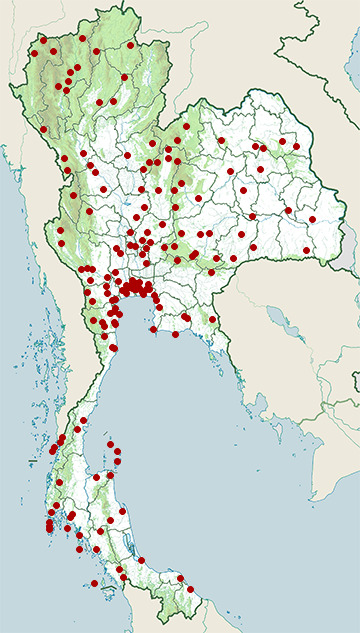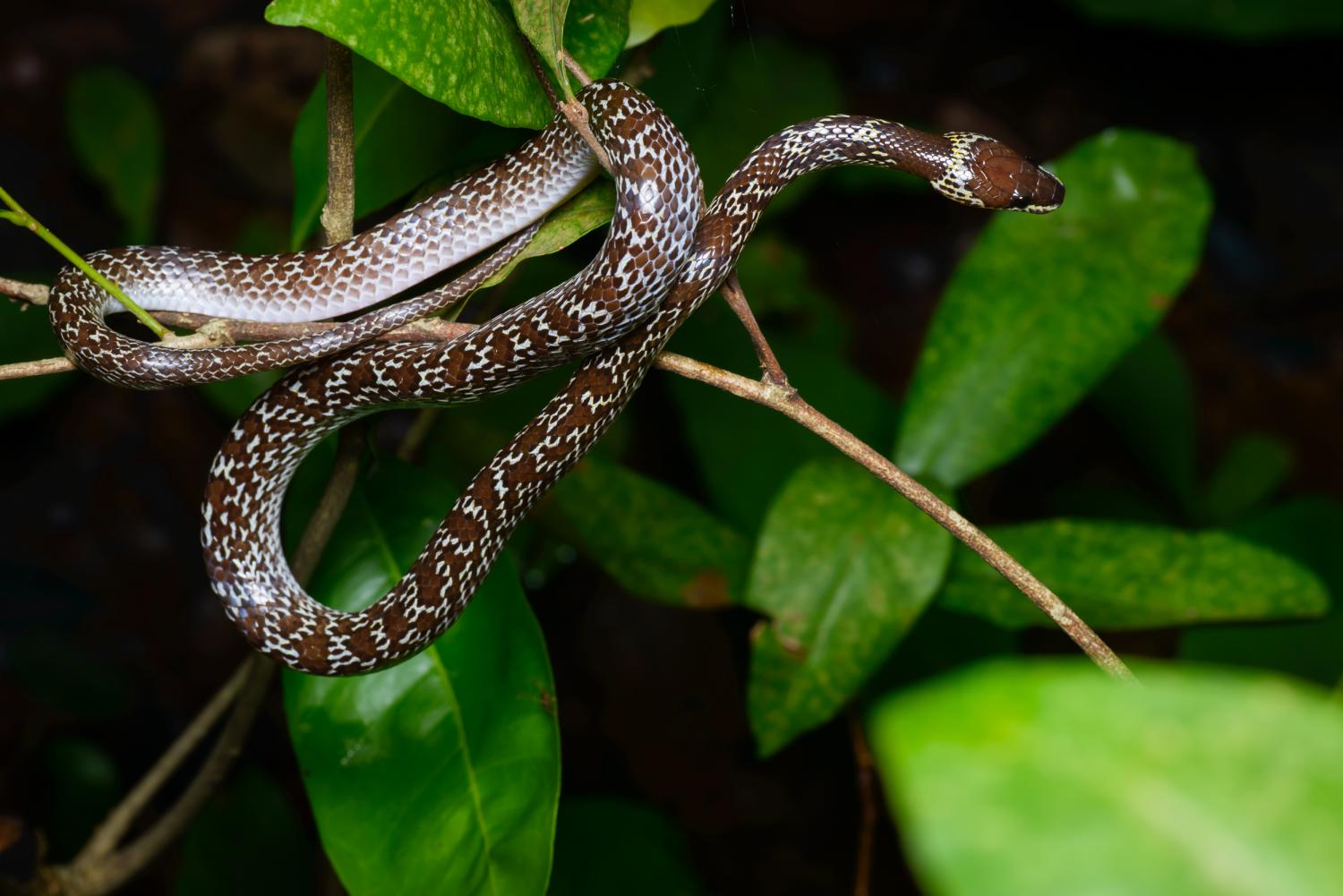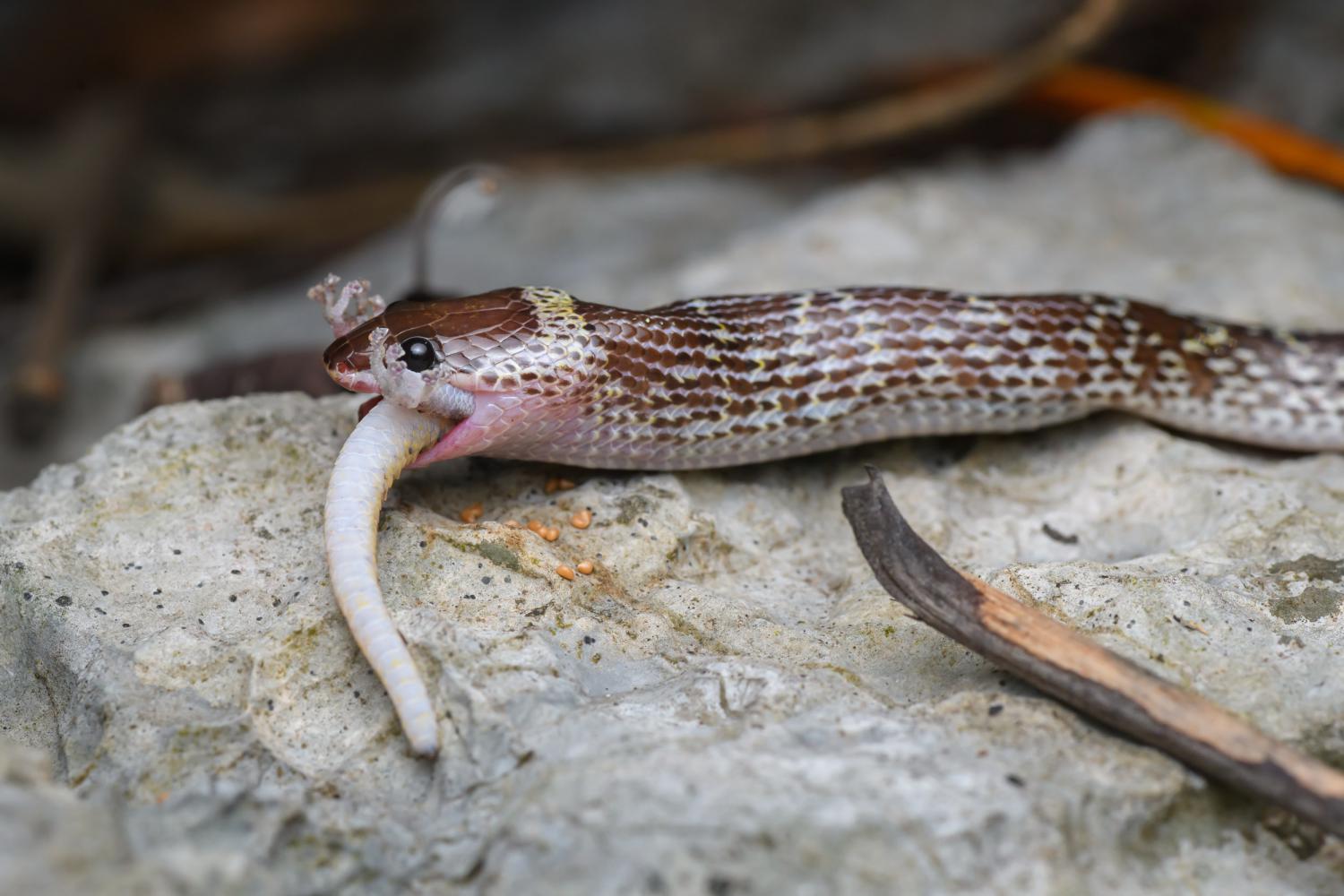Species of Thailand
Common wolf snake
Lycodon capucinus
Heinrich Boie in Friedrich Boie, 1827
In Thai: งูปล้องฉนวนสร้อยเหลือง (ngu plong cha nuan soy lueang)
Lycodon capucinus, also known as the common wolf snake, is a species of colubrid snake, which is commonly found in the Indo-Australian Archipelago. Named after their enlarged front teeth, which gives them a muzzled appearance similar to canines, it also makes the snout somewhat more squarish than other snakes.
Description
A slender-bodied small snake that ranges from barely three feet to less than one meter. Most wild-caught specimens usually reach less than these lengths. Coloration is adapted for life underground and on the forest floor. Shades of jet black, reddish-brown or dark gray with speckles, blotches and spots of white or pale yellow scattered over the body are its usual colors. There is also a distinct white coloration around its neck. Their color patterns vary from one geographic location to another. There are albino-colored ones which are very rare among this snake species. The snout is duck-bill-shaped for digging in soft or sandy ground. They have enlarged front teeth, this species is relatively benign (not harmful) to humans.
Distribution
The common wolf snake is found in Cambodia, Thailand, Vietnam, Singapore, Laos, SE China, Hong Kong, Indonesia (Sumatra, Java, Bali, Sumbawa, Sumba, Komodo, Flores, Lomblen, Alor, Sawu, Roti, Timor, Wetar, Babar Islands, Kalao, Salajar, Buton, Sulawesi), West Malaysia, Johor: Pulau Besar, Maldives, Mascarenes (Mauritius, Reunion; fide Glaw, pers. comm.), Borneo, and The Philippines (Bantayan, Bohol, Cebu, Cuyo, Leyte, Luzon, Pampanga, Masbate, Mindanao, Mindoro, Negros, Palawan, Panay, Romblon, Samar).
Behavior
The Common wolf snake is non-venomous. Even when they do bite humans, the impact is usually not harmful. Most bites result in pain and swelling, and do not result in any serious harm.
It is quite a nervous snake when picked up or handled and will not hesitate to bite. They may also move their tails in a to-and-fro motion much like a rattlesnake when they feel threatened. A fossorial animal, it loves burrowing down the earth but is most often found in open ground, on rocks or in low vegetation. Sometimes showing a semi-arboreal behavior. A nocturnal creature, it is most active during the night, but is also observed during daybreak.It also climbs on walls of any building. Most captive specimens become tame after some time and with proper handling.
Diet
In the wild, Lycodon capucinus feeds mainly on small lizards such as geckos and they are also among the top predators of skinks which makes it common to humans due to the abundance of prey near and in homes. They may also devour small frogs, if available. In captivity, they may be trained to feed on slender fishes such as goby or lizard-scented pinkie mice, though the latter proves to be harder.
Conservation status
The IUCN listed this species as of Least Concern.' Though a very common snake, it is seldom seen. Continuous destruction of primary and secondary forests, conversion of fertile lands to agricultural and residential areas as well as indiscriminate human killings can threaten the survival of this animal. It is endangered in numerous parts of mainland Asia and peninsular Southeast Asia.
This article uses material from Wikipedia released under the Creative Commons Attribution-Share-Alike Licence 3.0. Eventual photos shown in this page may or may not be from Wikipedia, please see the license details for photos in photo by-lines.
Scientific classification
- Kingdom
- Animalia
- Phylum
- Chordata
- Subphylum
- Vertebrata
- Class
- Reptilia
- Order
- Squamata
- Suborder
- Serpentes
- Family
- Colubridae
- Genus
- Lycodon
- Species
- Lycodon capucinus
Common names
- German: Kapuzen-Wolfszahnnatter
- English:
- Indian wolf snake
- Common wolf snake
- Thai: งูปล้องฉนวนสร้อยเหลือง (ngu plong cha nuan soy lueang)
Conservation status

Least Concern (IUCN3.1)
Photos
Please help us review our species pages if wrong photos are used or any other details in the page is wrong. We can be reached via our contact us page.
Range Map

- Amphawa District, Samut Songkhram
- Ban Kha District, Ratchaburi
- Ban Laem District, Phetchaburi
- Ban Lat District, Phetchaburi
- Ban Mo District, Saraburi
- Ban Phaeo District, Samut Sakhon
- Bang Bon District, Bangkok
- Bang Khae District, Bangkok
- Bang Khun Thian District, Bangkok
- Bang Pakong District, Chachoengsao
- Bang Phli District, Samut Prakan
- Bang Pu Recreation Centre
- Bang Sao Thong District, Samut Prakan
- Bang Yai District, Nonthaburi
- Bangkok Province
- Borabue District, Maha Sarakham
- Cha-Am District, Phetchaburi
- Chai Badan District, Lopburi
- Chai Prakan District, Chiang Mai
- Chaiyo District, Ang Thong
- Chaloem Phra Kiat District, Nakhon Ratchasima
- Chatuchak District, Bangkok
- Chiang Kham District, Phayao
- Chulabhorn District, Nakhon Si Thammarat
- Chumphon Buri District, Surin
- Dan Makham Tia District, Kanchanaburi
- Doi Inthanon National Park
- Doi Suthep - Pui National Park
- Don Chedi District, Suphan Buri
- Dong Charoen District, Phichit
- Hua Hin District, Prachuap Khiri Khan
- Huai Kha Khaeng Wildlife Sanctuary
- Huai Yot District, Trang
- In Buri District, Sing Buri
- Kaeng Krachan District, Phetchaburi
- Kaeng Krachan National Park
- Kamphaeng Saen District, Nakhon Pathom
- Kanchanadit District, Surat Thani
- Kantang District, Trang
- Kantharalak District, Sisaket
- Kham Muang District, Kalasin
- Khanom District, Nakhon Si Thammarat
- Khanu Woralaksaburi District, Kamphaeng Phet
- Khao Chamao District, Rayong
- Khao Chamao - Khao Wong National Park
- Khao Kho District, Phetchabun
- Khao Laem National Park
- Khao Nang Phanthurat Forest Park
- Khao Phanom Bencha National Park
- Khao Sam Roi Yot National Park
- Khao Sok National Park
- Khao Yai National Park
- Khlong San District, Bangkok
- Khok Samrong District, Lopburi
- Khuan Kalong District, Satun
- Ko Chang (South Thailand)
- Ko Lanta District, Krabi
- Ko Lanta National Park
- Ko Pha Ngan
- Ko Pha-ngan District, Surat Thani
- Ko Phayam
- Ko Samet
- Ko Samui District, Surat Thani
- Kosamphi Nakhon District, Kamphaeng Phet
- Krathum Baen District, Samut Sakhon
- Laem Pak Bia
- Lahan Sai District, Buriram
- Lam Nam Kra Buri National Park
- Lat Krabang District, Bangkok
- Lom Kao District, Phetchabun
- Lom Sak District, Phetchabun
- Long District, Phrae
- Mae Sot District, Tak
- Mae Tha, Lampang District, Lampang
- Mae Wang District, Chiang Mai
- Mae Yom National Park
- Maha Chana Chai District, Yasothon
- Muak Lek District, Saraburi
- Mueang Buriram District, Buriram
- Mueang Chaiyaphum District, Chaiyaphum
- Mueang Chonburi District, Chonburi
- Mueang Chumphon District, Chumphon
- Mueang Kalasin District, Kalasin
- Mueang Kamphaeng Phet District, Kamphaeng Phet
- Mueang Kanchanaburi District, Kanchanaburi
- Mueang Khon Kaen District, Khon Kaen
- Mueang Krabi District, Krabi
- Mueang Loei District, Loei
- Mueang Lopburi District, Lopburi
- Mueang Mae Hong Son District, Mae Hong Son
- Mueang Nakhon Pathom District, Nakhon Pathom
- Mueang Nakhon Ratchasima District, Nakhon Ratchasima
- Mueang Narathiwat District, Narathiwat
- Mueang Phang Nga District, Phang Nga
- Mueang Phetchaburi District, Phetchaburi
- Mueang Phitsanulok District, Phitsanulok
- Mueang Phuket District, Phuket
- Mueang Ranong District, Ranong
- Mueang Ratchaburi District, Ratchaburi
- Mueang Sakon Nakhon District, Sakon Nakhon
- Mueang Samut Prakan District, Samut Prakan
- Mueang Samut Sakhon District, Samut Sakhon
- Mueang Samut Songkhram District, Samut Songkhram
- Mueang Songkhla District, Songkhla
- Mueang Suphanburi District, Suphan Buri
- Mueang Tak District, Tak
- Mueang Ubon Ratchathani District, Ubon Ratchathani
- Nakhon Luang District, Phra Nakhon Si Ayutthaya
- Nakhon Thai District, Phitsanulok
- Nam Nao National Park
- Nong Bua Daeng District, Chaiyaphum
- Nong Khaem District, Bangkok
- Nong Phai District, Phetchabun
- Nong Wua So District, Udon Thani
- Pai District, Mae Hong Son
- Pak Chong District, Nakhon Ratchasima
- Pak Phanang District, Nakhon Si Thammarat
- Pang Mapha District, Mae Hong Son
- Pang Sida National Park
- Phaisali District, Nakhon Sawan
- Phakdi Chumphon District, Chaiyaphum
- Phasi Charoen District, Bangkok
- Phaya Thai District, Bangkok
- Phi Phi Islands
- Pho Thong District, Ang Thong
- Phop Phra District, Tak
- Photharam District, Ratchaburi
- Phra Phutthabat District, Saraburi
- Phra Pradaeng District, Samut Prakan
- Phu Luang Wildlife Sanctuary
- Phuket Province
- Pong Nam Ron District, Chanthaburi
- Prasat District, Surin
- Sai Buri District, Pattani
- Sai Yok District, Kanchanaburi
- Sakaerat Environmental Research Station
- Salak Pra Wildlife Sanctuary
- Sam Phran District, Nakhon Pathom
- Sam Roi Yot District, Prachuap Khiri Khan
- San Sai District, Chiang Mai
- Sattahip District, Chonburi
- Sawi District, Chumphon
- Si Racha District, Chonburi
- Sikhio District, Nakhon Ratchasima
- Soeng Sang District, Nakhon Ratchasima
- Suan Phueng District, Ratchaburi
- Tak Fa District, Nakhon Sawan
- Takua Thung District, Phang Nga
- Tarutao National Marine Park
- Tha Maka District, Kanchanaburi
- Tha Song Yang District, Tak
- Tha Yang District, Phetchaburi
- Thalang District, Phuket
- Thale Ban National Park
- Tham Pha Tha Phon Non-Hunting Area
- Thawi Watthana District, Bangkok
- Thep Sathit District, Chaiyaphum
- Thong Pha Phum District, Kanchanaburi
- Thung Khru District, Bangkok
- Thung Salaeng Luang National Park
- Umphang District, Tak
- Wang Nam Khiao District, Nakhon Ratchasima
- Wang Noi District, Phra Nakhon Si Ayutthaya
- Wang Sam Mo District, Udon Thani
- Wang Yang District, Nakhon Phanom
- Wiang Nong Long District, Lamphun
- Wiang Pa Pao District, Chiang Rai



